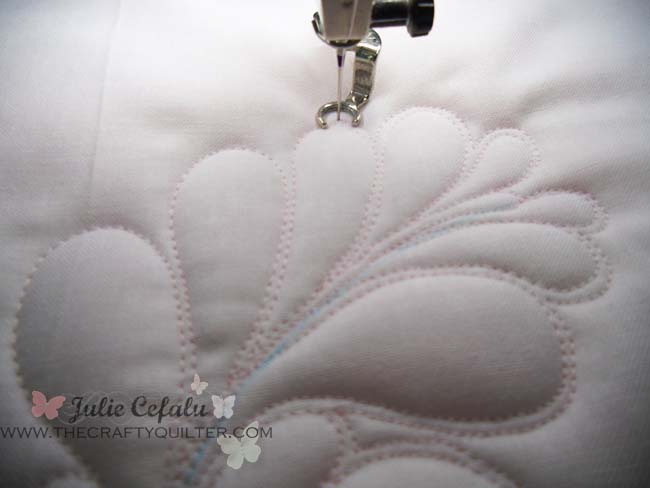Free Motion Quilting Challenge
I have just completed February’s Free Motion Quilting Challenge at Sew Cal Gal and it was a blast! I just discovered this challenge earlier this month and it’s been on my “to do” list for weeks. I love how it turned out!
This month’s guest teacher is Diane Gaudynski and she has been my idol for years. Diane does the most amazing free motion quilting and her feathers make me want to cry, they are so beautiful! Her tutorial is just like taking a class from her (I can only imagine since I haven’t had the opportunity).
She has you start with the feather’s spine. I decided to try a branching spine. I used my trusty blue water soluble pen to mark it with.
Once you feather to the top of the spine, you echo back down around the outside.
Now I have my feather completed. Whew! That took me about 30 minutes to complete.
I decided it needed some background stitching to make the feather really stand out. I thought I would try a design called Bouncing Bananas that Diane shows in her book, “Quilt Savvy, Gaudynski’s Machine Quilting Guidebook”.
It really does look like bouncing bananas, but I think my bananas are a little skinny.
It’s a nice change from the same old stippling and it adds great texture and interest too.
I have to admit that this technique takes a lot of practice to get right. I keep trying and it’s getting much better. The key is to practice, practice and relax while you’re doing it. A glass of wine or cup of tea can’t hurt either!
I can’t wait to see who next month’s teacher is going to be! To be part of the challenge go to Sew Cal Gal’s FMQ page and join today!















found your blog via the Granary newsletter, and it’s a pleasure to read.
What kind of machine are you using for free motion quilting?
I’d love to learn but I’ve been held back by the perception that it requires a very high end machine. Your thoughts?
Almost any machine is capable of free motion quilting. I use a Bernina 440 QE, but I have seen people in my classes with really old models and the fancy new ones and they have all worked. I’ll admit that some are better than others, but you can get your feet wet on any machine.
Most sewing machines have the ability to lower the feed dogs. You can check your manual on how to do this. If you can’t lower the feed dogs, then you can simply place scotch tape over them, making sure to leave the hole in the throat plate for the needle to go down uncovered. This will allow you to move your quilt underneath the needle in any direction you want.
I have also heard that you can leave your feed dogs up and try setting your stitch length to “0”. This will prevent the feed dogs from engaging and then you’ll have the ability to move the fabric in any direction.
All of the above steps assume that you’re working with a free motion foot on your machine. If you’re machine does not have one specifically for your model, you can get a generic one. Check with your local sewing machine repair shop or dealer.
You need to have an open mind when you try free motion quilting and don’t try to be a perfectionist. It takes lots of practice, but it should be fun! It’s a new experience, much like learning to play the piano or learning to ice skate. A little awkward at first, but easier as you go along.
Wow! Your feathers and banana shaped fillers are gorgeous! I agree with Pat you have a real talent for free motion quilting. Beautiful, stunning work! Bravo …well done! I want to free motion quilt like you when I grow up.
Simply stunning!! you should be giving lessons…..
Your feathers look so professional – no wobblies or wonkies – you have a real knack for these!
Your quilting is just gorgeous!